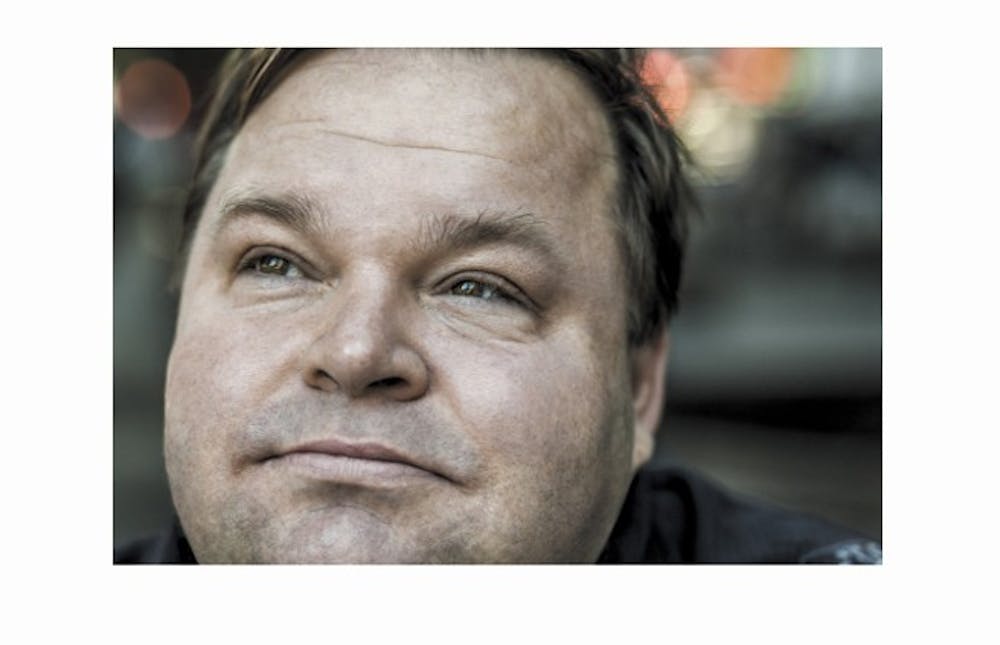Controversial performer Mike Daisey challenged the distinction between theater and journalism in a visit to Duke.
At 7 p.m. Monday evening, Daisey capped off a weeklong residency with Duke Performances by speaking at Manbites Dog Theater with Duke law professor Jedediah Purdy and Duncan Murell, writer-in-residence for the Center for Documentary Studies. He had just wrapped up a five-show run of his new monologue, “American Utopias,” at the PSI Theater at Durham Arts Council. In the show, Daisey deals with “how people create public spaces in which they come together to act out dreams of a better world” by exploring three such spaces: Disneyland, the Burning Man festival and the occupation of Zuccotti Park.
Daisey, however, comes with a certain amount of baggage since his earlier monologue “The Agony and the Ecstasy of Steve Jobs,” which described factory workers in the Chinese Foxconn Factory, aired on the radio show “This American Life” before it was revealed that he had fabricated encounters and events he described in the show. In response, “This American Life” pulled the monologue and issued a show called “Retraction,” which disavowed the show and featured a fifteen-minute interview with Daisey.
“We invited Mike to perform in Duke and Durham because he makes theater that is worthwhile, and he’s an incredible virtuoso in making the sort of theater he makes,” said Duke Performances Director Aaron Greenwald.
After Duke Performances invited Daisey, Greenwald said that he had gotten a letter from a student arguing against the booking because the retraction of Daisey’s monologue had hurt human rights efforts in China.
“There’s a kind of knee jerk reaction to him that does not take into account the broader spectrum of Daisey’s work,” Greenwald said.
He added that if there were to be a conversation around Daisey and the controversy of the Agony/Ecstasy performance, he would rather it be able to happen on Duke’s campus.
In regards to the retraction, Daisey argued in an interview with Recess last week that journalism itself used the tools of theater.
“The truth is that all stories are fiction, or more accurately, all stories are stories,” Daisey said.
After Agony/Ecstasy was retracted on “This American Life,” Daisey noted that someone said to him, “Never commit an act of journalism again,” but that his rejoinder was “when journalism stops using the tools of theater.”
He also argued that the “Retraction” episode of “This American Life” itself was a form of theater. According to Daisey, his interview with the show’s host Ira Glass, which had been condensed from a four-hour-long conversation, was the only fifteen minutes in the show’s history where the audio wasn’t mastered—so that Daisey’s every pause and breath could be heard.
Daisey would later revise “Agony/Ecstasy,” excising the encounters he had made up.
Sitting on a trio of armchairs Monday night, Daisey, Purdy and Murell discussed Purdy’s experiences in Zuccotti Park and evaluated Daisey’s monologue. Behind them was the set of “The New Electric Ballroom”—a play set to premier at Manbites Dog later this month—the two dresses hung on the mesh wall of the set hovering uncannily behind the three men’s heads.
Murrell moderated the talk and began by mentioning that he didn’t quite know what his role in the discussion was.
The bearded Daisey joked, “Start strong.”
Purdy described his experience visiting Zuccotti Park when the Occupy Wall Street movement was in full swing.
“The dorkiness of it drew me right there,” he said. “The library at Zuccotti Park had a very punctiliously maintained catalogue because it was run by librarians, but no record of the books that went out because they were all anarchist librarians.”
He noted, however, that a lot of effort went into making the temporary community livable for activists and that the encampment had an overarching sense of active participation.
Although Daisey had gone to Burning Man and Disneyland, he did not participate in the occupation of Zuccotti Park and described the movement as something that people viewed as “important, but I’m missing it anyway.”
“Most people did not have any of these experiences. This show was meant to activate you,” Daisey said.
In that token, “Utopias” ends with Daisey leaving the theater and inviting the audience to come along with him if they so choose to finish the monologue outdoors.
“Utopias” began with an invitation from his brother Chris to go to Disneyland, and Daisey immediately thought that he should write a monologue about both Disneyland and the Burning Man festival. During the time that he wrote the monologue, the Occupy Wall Street Movement happened, and Daisey incorporated the occupation of Zuccotti Park into his monologue.
He is planning to perform the monologue in New York in a found space two blocks down from Zuccotti Park so that during the end of the show the audience could walk down to the place where part of the monologue began.
Get The Chronicle straight to your inbox
Signup for our weekly newsletter. Cancel at any time.

